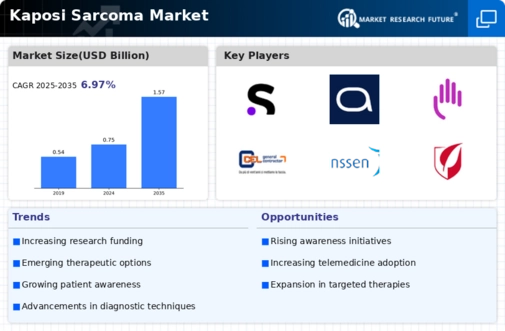The Kaposi Sarcoma Market is characterized by a complex interplay of competitive dynamics, driven by a combination of innovative therapies, strategic partnerships, and a growing emphasis on patient-centric approaches. Key players such as Gilead Sciences (US), Merck & Co (US), and Bristol-Myers Squibb (US) are at the forefront, each adopting distinct strategies to enhance their market presence. Gilead Sciences (US) focuses on developing novel antiviral therapies, leveraging its expertise in HIV treatment, which is crucial given the association between HIV and Kaposi Sarcoma. Meanwhile, Merck & Co (US) emphasizes immunotherapy, particularly with its PD-1 inhibitors, which have shown promise in treating various cancers, including Kaposi Sarcoma. Bristol-Myers Squibb (US) is also investing in combination therapies, aiming to improve patient outcomes through synergistic effects of its existing oncology portfolio. Collectively, these strategies not only enhance their competitive positioning but also contribute to a more robust therapeutic landscape for Kaposi Sarcoma.
In terms of business tactics, companies are increasingly localizing manufacturing and optimizing supply chains to ensure timely access to therapies. The Kaposi Sarcoma Market appears moderately fragmented, with several players vying for market share. However, the influence of major companies is substantial, as they often set the pace for innovation and market trends. Their ability to navigate regulatory landscapes and establish strong distribution networks further solidifies their positions within this competitive structure.
In August 2025, Gilead Sciences (US) announced a collaboration with a leading biotechnology firm to develop a novel combination therapy targeting Kaposi Sarcoma. This strategic move is significant as it not only expands Gilead's oncology portfolio but also aligns with the growing trend of personalized medicine, potentially improving treatment efficacy for patients. The partnership is expected to leverage both companies' strengths in research and development, thereby accelerating the timeline for bringing new therapies to market.
In September 2025, Merck & Co (US) launched a clinical trial evaluating the effectiveness of its PD-1 inhibitor in patients with advanced Kaposi Sarcoma. This initiative underscores Merck's commitment to exploring innovative treatment options and reflects a broader trend towards immunotherapy in oncology. The trial's outcomes could provide critical insights into the role of immune modulation in managing this rare cancer, potentially reshaping treatment protocols.
In July 2025, Bristol-Myers Squibb (US) expanded its partnership with a global health organization to enhance access to its cancer therapies in underserved regions. This strategic action not only demonstrates the company's dedication to improving health equity but also positions it favorably in a market increasingly focused on social responsibility. By addressing access issues, Bristol-Myers Squibb is likely to strengthen its brand reputation and foster loyalty among healthcare providers and patients alike.
As of October 2025, the competitive landscape of the Kaposi Sarcoma Market is increasingly defined by trends such as digitalization, sustainability, and the integration of artificial intelligence in drug development. Strategic alliances are becoming more prevalent, as companies recognize the value of collaboration in navigating complex regulatory environments and enhancing research capabilities. Looking ahead, competitive differentiation is expected to evolve, with a shift from traditional price-based competition towards a focus on innovation, technological advancements, and supply chain reliability. This transition may ultimately lead to improved patient outcomes and a more sustainable market environment.

















Leave a Comment